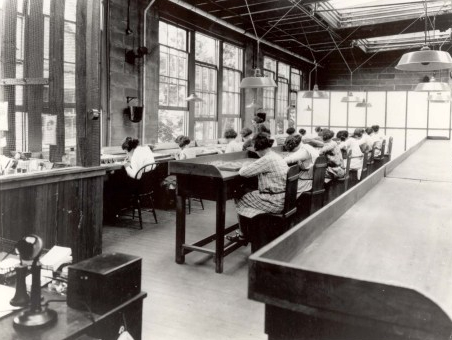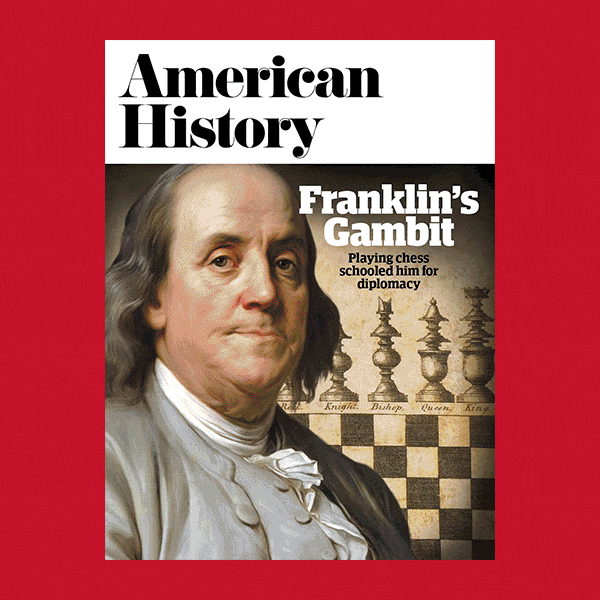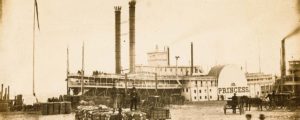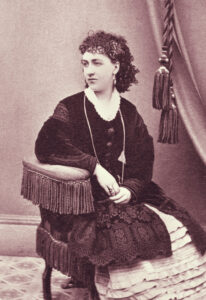When Grace Fryer landed a job at the United States Radium Corporation factory in Orange, New Jersey, in 1917, she must have felt special and very lucky. Along with 70 other young women hired at the plant that spring, Fryer would be earning more than triple the average factory-floor wage to apply a newly formulated luminescent paint to watches, clocks, compasses and an assortment of military instruments. Upon the United States entry into World War I in April, there developed a demand for a wide variety of devices to be coated with the glowing radium-treated paint, trade named Undark. U.S. Radium needed hundreds of new workers to fulfill its lucrative contracts and found young women to be ideally suited for the intense concentration and nimble handwork that dial painting required. It was comfortable and pleasant compared to most factory work of the time, and the dial painters had no reason to believe this amazing new substance called radium wasn’t perfectly safe to work with.
As has often been repeated in the past century and a half of quantum leaps in science, industry and medicine, overexuberance to adopt the latest discoveries has sometimes surpassed our ability to completely understand their potential negative effects. One striking example of this is the case of the “Radium Girls”—five U.S. Radium dial painters who contributed significantly to expanding the legal protections afforded American workers and increasing public awareness of the dangers of radioactivity.
GET HISTORY’S GREATEST TALES—RIGHT IN YOUR INBOX
Subscribe to our HistoryNet Now! newsletter for the best of the past, delivered every Monday and Thursday.
Early Identification of Radioactivity
Radioactivity was a relatively new and poorly understood phenomenon in the early 20th century. German physicist Wilhelm Conrad Roentgen discovered X-rays, and their initial diagnostic value, in 1895. Since the rays could not be felt by the senses, and there seemed to be no immediate effect on exposed skin, the general consensus was that X-rays were harmless.
There were, however, reports of X–ray related injuries as early as 1896, including the case of Thomas Edison’s assistant, Clarence Dally, who suffered from severe radiodermatitis that resulted in the amputation of his arm and his subsequent death in 1904. By the late 1890s, there were numerous reports in scientific literature of radiation skin burns and loss of hair, testimony to the apparent cavalier attitudes and the large doses being used. Ironically, those reports of radiation injury led physicians to recognize the possible therapeutic value of the rays in treating inoperable cancers.
Within weeks of Roentgen’s discovery of X-rays, Henri Becquerel identified radioactivity, and in 1898 Marie and Pierre Curie reported the discovery of the chemical element radium, found in trace amounts in uranium ores. The Curies were amazed and delighted that their new element glowed in the dark. Soon radium was being hailed as the wonder substance of the new 20th century, and was ascribed the power to cure everything from arthritis to cancer. The potential of radium seemed infinite but the hazards of working directly with radioactivity were not yet widely recognized, and many scientists, including the Curies, suffered skin lesions— often from carrying samples of radioactive materials in their pockets.
In 1902 radium was isolated into pure metal by Marie Curie and André-Louis Debierne. Soon after that the American electrical engineer William J. Hammer concocted a radium paint that could be used on scientific instruments to make them visible in the dark. At that time, however, the mining and extraction of radium was very expensive. But with the onset of World War I, its application to military instruments and watches drove an ever-burgeoning demand.
Young Women Hired to Paint Gadgets
Between 1917 and 1929, hundreds of young women were employed applying radium-activated paint to watches, aircraft controls, clocks and compass faces in factories in Illinois, New Jersey, Connecticut and Long Island, N.Y. Painting an average of 250 dials per day and getting about a penny and a half per dial, the women at Radium Dial’s Ottawa, Ill., plant could earn about $18 a week, compared to the $5 they would likely earn in other factory jobs.
Working with a mixture of glue, water and radium powder, the dial painters used camel’s hair brushes to apply the glowing paint to racks of dials. For fun, the young women would sometimes paint their fingernails and teeth with the glowing mixture and then turn off the lights. At times, with the factories often full of radium dust, it was reported that the women’s skin and hair sometimes glowed by the time they left work. One worker noted that when she blew her nose, her handkerchief glowed in the dark.
Tracing the tiny numbers on watches and compasses required precision brush strokes, and the women were encouraged by their supervisors to use their lips to help make a fine point on their brushes. Reassuring them that the glowing substance in the paint was not dangerous, women later quoted their bosses telling them, “Not to worry if you swallow any radium, it’ll make your cheeks rosy.” In spite of those assurances to the young workers, however, factory owners and scientists carefully avoided overexposure themselves, wearing protective masks and using lead screens and tongs when handling the radium.
Mysterious Health Problems, Then Suspicious Deaths
Over time, the factory workers absorbed substantial amounts of radium into their bodies, and by the early 1920s, dial painters were falling ill with mysterious symptoms. Many developed problems with their teeth, and their jawbones appeared to be disintegrating. They frequently suffered from severe anemia and debilitating joint pain as well. Dr. Theodor Blum, a dentist in New York, was the first to link the painters’ symptoms to their work, coining the term “radium jaw” in a 1924 article in the Journal of the American Dental Association.
Grace Fryer would later testify against U.S. Radium in court: “Our instructors told us to point [our brushes] with our lips. I think I pointed mine with my lips about six times to every watch dial. It didn’t taste funny. It didn’t have any taste, and I didn’t think it was harmful.” Fryer left the dial factory after about three years, in 1920, for a better job as a bank teller. About two years later, her teeth started falling out and her jaw developed a painful abscess. She consulted a number of dentists and doctors, but none had ever seen such serious bone decay. Finally in 1925, one doctor suggested that the problems might be caused by her years as a dial painter.
Fryer might have remained just another unknown victim of radiation poisoning if the National Consumers League and noted newspaperman Walter Lippmann hadn’t championed her cause. Established in 1899, the Consumers League fought for safe workplaces, reasonable minimum wages and decent working hours for women and children.
It was at the request of an Orange city health department official that the New Jersey branch of the league began investigating the suspicious deaths of four radium factory workers between 1922 and 1924. The deaths had been attributed to phosphorous poisoning, mouth ulcers and syphilis. The New Jersey Consumers League chairwoman, Katherine Wiley, brought in statistical experts and Alice Hamilton, a Harvard University authority on workers’ health issues, to investigate the mysterious injuries and deaths among former dial painters.
Former Dial-Painters Sue for Compensation
Fryer decided to sue U.S. Radium in 1925, but it took her two years to find an attorney willing to take the case. In May 1927, Fryer and four other former dial painters—Edna Hussman, Albina Larice, Quinta McDonald and Katherine Schaub—filed suit in the New Jersey State Supreme Court for $250,000 each in compensation for medical expenses and pain. The case quickly grew into a media phenomenon and the press dubbed the five young women the “Radium Girls.” The crusading journalist Lippmann wrote a number of stories concerning the Radium Girls in the New York World, arguably the most influential newspaper in the country at the time.
U.S. Radium denied all charges of knowingly poisoning its dial painters, and launched a campaign of disinformation. In 1925 the corporation hired Frederick Flinn of the Institute of Public Health at Columbia University to give Fryer a medical examination. He found her health “as good as my own.” It was later discovered that Flinn was not a licensed medical doctor, but an industrial toxicologist on contract with U.S. Radium to try to refute the Harvard health team’s report. As dial worker after dial worker fell ill, U.S. Radium attempted to tarnish the women’s reputations by claiming that they were suffering from syphilis.
However, scientific and medical literature dating back to 1906 contained plenty of information concerning the hazards of working directly with radium. Even one of U.S. Radium’s own publications contained a section called “Radium Dangers— Injurious Effects.” Despite these warnings, radium was still widely touted as a scientific miracle with enormous curative power. Newspapers, magazines, books and lectures heralded the spectacular cancer-curing properties of radioactive concoctions such as Radithor, sold over the counter to unsuspecting customers. It was later found that Radithor contained enough radium to kill the thousands who drank it regularly until 1931, when the Federal Trade Commission issued a cease-and-desist order against the manufacturer.
Legal maneuvering in the Radium Girls’ case delayed the first hearing until January 1928. By that time it was painfully clear the five women were seriously ill, and when the defense was granted a five-month adjournment in April, the public outcry was swift and fierce. Lippmann decried the action as “one of the most damnable travesties on justice that has ever come to our attention.” Even Marie Curie commented on the Radium Girls’ likely fate: “I see no hope for them….My experiments with radium convince me that if the poison is taken internally, it is practically impossible to destroy it.” (Curie herself would die in 1934 of aplastic pernicious anemia caused by long-term exposure to radium.)
A trial date was set for June, but just days before it was to begin, the Radium Girls settled out of court for $10,000 each, plus coverage of medical expenses and a $600 annuity until death. McDonald died in 1929 at the age of 34; the 34-year-old Fryer and Schaub, 30, died in 1933, followed by Hussman in 1939 at age 37. Larice, the last of the Radium Girls, died in 1946 at 51.
Women’s Bravery Shapes Federal Laws
The perseverance of the Radium Girls and their courage to challenge U.S. Radium even as they were dying set a precedent in case law for the right of individual workers to sue employers for damages caused by labor abuse. In the wake of their legal battle, industrial safety standards were enhanced by the passage of federal laws that made occupational diseases compensable and extended the time during which workers could discover illnesses and make claims. Furthermore, data developed from the experiences of these unfortunate young women was instrumental in setting new radium tolerance levels for researchers and workers.
Perhaps the fate of the Radium Girls was sealed when they first started dipping their brushes into that strange glow-in-the-dark paint back in 1917, but in their misfortune the American public would learn an important lesson. The scientific community in the early 1900s promoted radioactivity as safe and harmless, and nonscientists were reluctant to question or criticize. The Radium Girls challenged the power and claims of a major corporation and, in doing so, not only warned the public of the deadly effects of radium, but also illuminated the danger of trusting blindly in new discoveries and technologies.
historynet magazines
Our 9 best-selling history titles feature in-depth storytelling and iconic imagery to engage and inform on the people, the wars, and the events that shaped America and the world.







